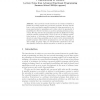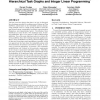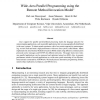1299 search results - page 10 / 260 » Why Not Use a Pattern-Based Parallel Programming System |
ICPP
2007
IEEE
14 years 1 months ago
2007
IEEE
We propose and evaluate a novel approach for automatic parallelization. The approach uses traces as units of parallel work. We discuss the benefits and challenges of the use of t...
AFP
2008
Springer
14 years 1 months ago
2008
Springer
This practical tutorial introduces the features available in Haskell for writing parallel and concurrent programs. We first describe how to write semi-explicit parallel programs b...
CODES
2010
IEEE
13 years 5 months ago
2010
IEEE
The last years have shown that there is no way to disregard the advantages provided by multiprocessor System-on-Chip (MPSoC) architectures in the embedded systems domain. Using mu...
PVM
1999
Springer
13 years 11 months ago
1999
Springer
Abstract. With the growing importance of fast system area networks in the parallel community, it is becoming common for message passing programs to run in multi-programming environ...
CONCURRENCY
2000
13 years 7 months ago
2000
Java's support for parallel and distributed processing makes the language attractive for metacomputing applications, such as parallel applications that run on geographically ...



